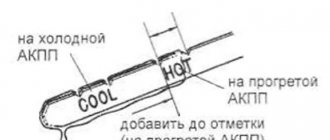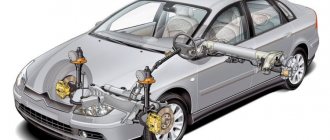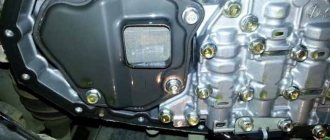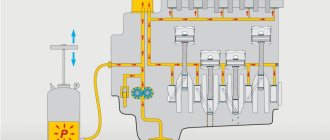Toyota cars are incredibly popular among drivers. This brand has gained a strong leading position. There are quite a few factors contributing to this effect. However, the positive impression was formed primarily because of the incredible reliability.
Toyota cars rarely break down. They are able to withstand serious loads. The company pays special attention to the development of various components and assemblies. Such high results are achieved through a multi-stage quality control procedure. This can also be seen in the reviews of the Rav 4 variator. The unit is reliable. Moreover, the efficiency of its operation was not even affected by the serious complication of the design.
Review of the Rav 4 variator: reliable, but I didn’t have enough
I owned a Rav 4 with a CVT for about a year. Then I sold it and bought the same device, but with a gun. In general, the impression of use was only positive.
I bought the car secondhand. Of the minuses of this car, I will name only 2 factors:
- mileage of 50 thousand km;
- interior is a little shabby.
Well, apparently, the car was used harshly before me. I myself drive a lot; in a year of ownership I have driven about 40 thousand km. I don't have any complaints about the box. My review of the Rav 4 variator is extremely positive. Switching is quite quick. The machine never stalled.
However, there are also disadvantages. I didn't have enough power when accelerating. Acceleration seemed slow to me. I waited like this for a whole year, as a result of which I decided to sell.
Overall, I recommend buying the car. I myself have only positive impressions. There were no breakdowns or other “joys”. The reason for changing the car was indicated above. If the car picked up faster and was revvy, I would leave it.
The new Toyota RAV4 with a CVT turned out to be better than the version with automatic transmission
The endless debate about transmissions continues and motorists must choose: robot, stick, automatic or CVT.
Today, the reason for discussion will be the confrontation between a CVT and an automatic transmission on one of the most popular cars in Russia - the Toyota RAV4.
Before starting the discussion, it is worth exploring the technical potential of the model. The engine compartment is occupied by two versions of engines: 2.0 and 2.5-liter fours with 149 and 199 horsepower. the younger brother relies on a pair of manual transmission and CVT, but the larger and more productive internal combustion engine relies exclusively on the classic “automatic”.
Which transmission is better, automatic will soon go into oblivion? As experts and car owners note, the two-liter RAV4 has a smooth ride, and when paired with a CVT, there are no jerks and a little lacking in dynamics. Despite the slight suffocation of the engine, fuel economy and a comfortable ride are observed. Therefore, the once unloved CVT is gradually filling the niche of transmissions, appearing on an increasing number of cars. Toyota, Nissan, Renault, not to mention Mitsubishi. Now the Chevrolet and Ford brands are actively working on their own CVTs.
It is quite problematic to distinguish the variator visually, since the imitation of gear shifting is identical. It is noteworthy that the RAV4 with a CVT saves fuel in the city, and on the highway the good old automatic transmission clearly wins. In addition, the automatic has 8 stages, which made it possible to “spread” the revolutions in more acceptable ranges. In 2022, the CVT has a chance to become the No. 1 transmission.
Source
It does not matter
The Rafik now has two engines on the Russian market. Diesel was fired without regret: demand was low. Gasoline units are from the new Dynamic Force family. These are atmospherics. The compression ratio of 13 makes them similar to Mazda’s Skyactiv engine, which has an even higher ratio of 14. And the main parameters are close: 149 hp from two liters, 199 hp from two and a half.
The two-liter engine reveals itself immediately. Lucky for his strength honestly, but sadly. On flat roads it is enough, for the city too, but short sections of dotted markings on serpentines put a taboo on overtaking.
A variator of an original design works in tandem with it. A gear first gear was added to it, operating at low speeds. It removes unpleasant loads from the belt during quick starts on the asphalt and when driving under tension on the roads.
There is no difference with the classic CVT. The benefit should manifest itself in an increase in resource. In general, the variator works flawlessly. I especially liked the ten virtual steps.
I expected more from the 200-horsepower 2.5 unit. The Mazda CX‑5 drives very cheerfully with this, as do the Tiguan and Kodiak, equipped with a 180‑horsepower TSI. And in the case of the RAV4, I don’t believe in the passport 8.5 seconds to hundreds. The engine makes a loud noise when accelerating, spins smoothly, but is absolutely unemotional. Yes, it's a Toyota.
There is not a single complaint about the eight-speed automatic transmission that assists the engine: it doesn’t get confused in the gears, and responds immediately to pressing the gas. The only thing that bothered me was the fuel consumption. I didn’t “light up” too much, but, according to the trip computer, I didn’t meet 11 l/100 km in highway mode.
Toyota Rav 4 automatic or variator, how to determine which is better
The manufacturer equips Toyota RAV4 cars with a CVT, automatic or manual transmission. A continuously variable transmission makes the car more economical and requires compliance with operating recommendations. The Toyota RAV 4 automatic transmission provides the driver with ease of operation and has an acceptable service life. However, fuel consumption can be quite high. The mechanics are difficult to operate, but are cheaper, easy to maintain and durable. The car shows excellent dynamics, and the driver can fully control the vehicle. A compromise option between a manual transmission and an automatic transmission is a robot.
Review of gearboxes on Toyota RAV4 cars
The fourth generation RAV 4 transmission is equipped with two types of automatic transmissions - U660E and U760E, which are similar in design, therefore most of the units and components are interchangeable.
The 5th generation Toyota has an 8-speed DirectShift-8AT automatic transmission. It changes gears instantly, and its power output range is impressive. The manufacturer uses new technology for grinding gears and clutch linings specially designed for this unit.
The classic design of the variator did not allow off-road driving, and slipping sometimes became fatal. To eliminate this problem, the developers decided to equip the Direct Shift-CVT with a mechanical first gear with classic gears. At the same time, all the advantages of the checkpoint were preserved.
The first gear with a gear drive helps the car to better accelerate from a standstill and successfully get out of liquid mud or snowdrifts without damaging the gearbox. The efficiency of a toothed element is much higher than that of a conventional timing belt. Gearing helps reduce energy loss and stress on machinery. In addition to the starting gear, the box has a sports mode, capable of simulating the operation of a 10-speed sequential gearbox.
The transmission has a complex design with a large number of parts, which has increased its reliability and extended its service life.
There are several ways to determine whether a Toyota RAV 4 has an automatic or a CVT:
A car with an automatic transmission will slowly move forward at idle, but with a CVT it will roll back a little and just stop.
Automatic transmission design
Models 2007-2008. equipped with a four-speed automatic transmission. Cars with an engine capacity of 2 liters are paired with a 6-speed automatic transmission of the U761E and U760E modifications, providing excellent dynamics. The 3.5 liter power unit is equipped with an 8-speed DirectShift-8AT gearbox. A lighter transmission makes the car dynamic, instantly responding to pressing the gas pedal.
Toyota with automatic transmission
The gearbox operates without long delays, speeds are switched smoothly, almost imperceptibly for passengers. Provides comfortable travel at low speeds and quick acceleration from a standstill.
The manufacturer indicates in the instructions that 6- and 8-speed Aisin automatic transmissions are designed for 200 thousand kilometers, and an oil change will not be required during this service life. As practice shows, ATF WS transmission fluid, specially created for Toyota cars, has to be changed every 50 thousand km. The condition of the oil must be constantly monitored.
If it is heavily soiled, it should be replaced so that the transmission can operate for a long time without interruption.
Reviews of RAV 4 with automatic transmission
According to some car owners, the RAV 4 automatic is not a very reliable unit. Breakdowns often occur, mainly due to a malfunction of the computer, and in this case major expensive repairs are almost always required, the costs amount to 90 thousand rubles. Some, on the contrary, consider the Toyota RAV4 with automatic transmission to be the optimal choice, despite the fact that in winter it consumes 10-15 liters of gasoline when used inside the city.
The 20th century is coming
The interior supports brutal design moves on the body. The deliberately large climate control knobs and square multimedia display fit well into it. Many will advise you to tear it off, but I’ve gotten used to the fashion for separately protruding “TVs”.
I don’t like touch controls for everything: it’s inconvenient in a car. But in the RAV4, on the sides of the screen there are keys from a Japanese calculator from the eighties. A little younger - seat heating buttons. It’s good, at least they don’t set electronic clocks anymore.
The average Toyota buyer is not young, and you won’t be deterred by a bad multimedia system. But the TNGA architecture, fresh design and everything else were conceived with the goal of rejuvenating the audience: with the new RAV4, marketers are counting on 64% of new customers who have not previously owned Toyotas. How can you achieve this with such displays?
Of course, there are also successful solutions. For example, rubberized internal door handles, microclimate and “music” control knobs. The abundance of sockets corresponds to the times: there are seven of them in the cabin and trunk - two 12-volt and five USB connectors. Plus wireless smartphone charging.
There is room in the back for three adults. The trunk has grown in volume to 580 liters “under the curtain” and acquired a double-sided floor. If you need to transport something dirty, you can turn it over - instead of a civilian pile cover, get an easy-to-clean rubber one.
Heated front seats, steering wheel and windshield washer nozzles are already included in the “base”. As standard, the car's windshield is heated only in the rest zone of the wipers. Such a penny saving is incomprehensible, because the other three levels of equipment imply heating throughout the entire area.
There are other absurdities too. For example, the driver's seat has ten electrical adjustments and a memory function, but the passenger is not even offered a height adjustment. They also did not introduce a panoramic roof and cornering headlights, although the price seems to oblige them to be available. And the manually controlled air conditioning in the initial configuration seems like an inappropriate saving.
Let me summarize. Toyota RAV4 looks interesting, drives nicely and can surprise you off-road. But when you compare the number of options and the price, the new car is discouraging. For 1.76 million rubles they offer a crossover with a “handle”, without climate control and parking sensors. The option with all-wheel drive will cost at least 2.09 million, and for a copy with top-end equipment, please pay 2.66 million rubles. And these are Russian-assembled cars!
Everything from localized competitors is cheaper. The RAV4, of course, won’t leave the top 25 in sales: buyers who repeat the mantra “It’s a Toyota!” won’t be scared off by the price.
However, it will be difficult to catch up with the Kia Sportage and Volkswagen Tiguan crossovers that have moved ahead. And this is the main market task for the ambitious Toyota.
| Changed design added attractiveness | A significant surcharge for a brand will push away new buyers |
Design and principle of operation of the Toyota RAV4 variator
Since 2005, CVTs for Toyota have been from the Japanese manufacturer Aisin. Popular front- and all-wheel drive versions of the car are K 111 and K111F. Installed on cars with an engine up to 2 liters. The box is fully controlled by a hydraulic unit with five solenoids. Elements of the variator device:
The gear shift is smooth and stepless, which ensures the connection and disconnection of the drive belt and pulleys.
The drive is V-belt or gear driven. At the start, the stage with a gear mechanism begins to work, then the transition to a belt drive is made.
Warm-up techniques
Warming up while moving
You can start the movement immediately without warming up. But it is important to follow certain rules. You need to start and brake smoothly, without accelerating at high speeds. Then the variator will warm up faster and more smoothly. Similar tactics can be used when leaving the yard. During the distance from the garage to the free street, the variator will have time to warm up. It’s also a plus for residents of settlements with rail and air crossings (there are some, but they’re rare. The most famous is Gibraltar. Author’s note). The main thing is to wedge into the flow at low speed just before closing or immediately after opening.
Warming up in the parking lot
Starting the engine from 5 to 20 minutes before departure is a classic scheme for warming up the engine and variator. This time can be spent usefully. Most cars with a CVT are equipped with a standard on-board system and navigation. While the engine is warming up, we recommend looking at traffic jams on the route or viewing the recording from the recorder, if available.
Possible breakdowns with automatic transmission and CVT gearboxes
Almost all automatic transmissions and CVTs of Toyota RAV4 require strict adherence to the rules for replacing transmission fluid. The quality of the latter should be good. If you do not change the automatic transmission lubricant and filter in time, you will soon have to repair the unit.
Friction clutches fail after 150-200 thousand kilometers. This is indicated by the smell of burnt oil and its severe contamination.
With careful driving, car mechanisms will last up to 500 thousand km or more.
Problems with the mechanics of automatic transmission U140-U241 do not arise until the mileage indicator on the odometer is 1 million km. With an aggressive driving style at 400 thousand km, the planetary gear may be damaged. Heavy loads and dirty lubrication cause the axes of the satellite gears to fly apart. As a result, the contact patch of the gears is reduced and the destruction of teeth is accelerated.
If repairs are not carried out, large abrasive particles enter the pump and begin to damage it, and then other components of the automatic transmission, for example, the hub under the clutches.
The pump bushing will need to be replaced after 130-150 thousand km if you drive for a long time with contaminated lubricant and a reduced volume.
If an oil leak occurs, you will need to go through the entire box, replace the seals and gaskets. With a mileage of 150-200 thousand km, solenoids U660E and U760E sometimes become clogged with torque converter wear products. The problem can be solved by changing the lubricant more frequently. At a mileage of 130-190 thousand km, U660E bearings fail. Due to the increased load, a howl from the gearbox begins to be heard at 70 thousand km.
Most breakdowns occur due to the fault of the owner, who does not properly monitor the condition of his car.
The following are not allowed in CVT:
It should be taken into account that the automatic RAV4 is designed for driving in urban conditions. On unpaved and snow-covered tracks, the mechanisms are at risk of overheating and reduced service life.
The crankshaft overheats and wears out under constant high-speed conditions, such as on the autobahn.
Toyota Rav 4 CVT or automatic: which is better
The decision which is better - a Toyota RAV 4 CVT or automatic - should be made based on the specific needs of the driver. It's worth testing both models for yourself.
Automatic transmission is distinguished by increased service life, reliability and maintainability. Capable of operating up to 300 thousand km. The variator ensures the absence of jerks when changing gears, smooth acceleration, low fuel consumption, but sometimes it is noisy and its resource is limited; problems for owners begin after a mileage of 100 thousand km.
Disadvantages of CVT transmission:
However, many still prefer SUVs with a CVT.
If the driver expects to operate the car for three years until the warranty expires, then it is worth choosing a CVT - then you will save on fuel. When you plan to drive for more than 4-5 years, it is more profitable to take a car with an automatic transmission: this way the car will last longer. Although, it all depends on the specific brand and model.
Source
Operational resource
| The transmission resource directly depended on the driving style. With careful driving, the variator could last about 300 thousand, without requiring any significant costs for replacing cones and cleaning the valve body. |
If the car owner neglected the service, did not change the oil in a timely manner, and often accelerated from a stop with slipping and on unheated oil, then in this case accelerated wear of the iron was noted, and repair of the variator was required at a mileage of 100 thousand.
Rav 4 2022 CVT or automatic which is better
You, as the first owner, will not have to worry about the variator, unless of course you plan to drive the car for more than 200 thousand km. On my right-handed Japanese car, the mileage at the time of sale was 130t.km, there was no hint of possible breakdowns of the variator. Just change your oil on time.
Read this thread: link
satori @ 25.3.2013, 7:48
You, as the first owner, will not have to worry about the variator, unless of course you plan to drive the car for more than 200 thousand km. On my right-handed Japanese car, the mileage at the time of sale was 130t.km, there was no hint of possible breakdowns of the variator. Just change your oil on time.
What are you guys talking about, what bad dynamics?)))) I don’t even use the sport mode, there’s enough dynamics - by the way, I already posted somewhere that I switched from turbodiesel mechanics to exhaustion and the loss of dynamics is practically not noticeable, well, a maximum of 15% in normal mode. in sports, on the contrary, you feel that it’s quite enough when overtaking, and on a snowy road. I now have variator 2 on the new rough, given the weight of the car, variator 2.0 is enough for dynamic driving. for example, a Dodge 1.8 caliber manual was not enough at speeds above 120. I had it about 5 years ago))) if you doubt whether a 2.0 variator will be enough for you, then as an option, try to find someone from your city with a request to ride it regarding the performance pipes for 2.5 I’m just wondering how you are going to damage it? In theory there is nothing in the forest or snow. although I hit a tree stump. there will only be danger from something like a concrete ledge
garia44 @ 26.3.2013, 2:29
What are you guys talking about, what bad dynamics?)))) I don’t even use the sport mode, there’s enough dynamics - by the way, I already posted somewhere that I switched from turbodiesel mechanics to exhaustion and the loss of dynamics is practically not noticeable, well, a maximum of 15% in normal mode. in sports, on the contrary, you feel that it’s quite enough when overtaking, and on a snowy road. I now have variator 2 on the new rough, given the weight of the car, variator 2.0 is enough for dynamic driving. for example, a Dodge 1.8 caliber manual was not enough at speeds above 120. I had it about 5 years ago))) if you doubt whether a 2.0 variator will be enough for you, then as an option, try to find someone from your city with a request to ride it regarding the performance pipes for 2.5 I’m just wondering how you are going to damage it? In theory there is nothing in the forest or snow. although I hit a tree stump. there will only be danger from something like a concrete ledge
Boltik @ 28.3.2013, 9:56
About the CVT, my cousin works as a service consultant at Auto-Dream, this is Toyota Vladimir.
Boltik @ 28.3.2013, 9:56
About the CVT, my cousin works as a service consultant at Auto-Dream, this is Toyota Vladimir. A couple of days ago, a Rav-4(3) was brought to them for repairs, the diagnosis was that the input shaft bearing in the variator had fallen apart, guess what! MILEAGE 340,000 km, WOW! This is the first case with a CVT in their technical center. The cars are serviced with variable speed brakes, they have mileage of 150, and there are some for 200 thousand, and everything is OK.
Source
CVT brand Rav 4
CVT gearboxes similar to modern ones appeared in Toyota cars in the early 1990s. One of the first production models with this solution is the RAV4 SUV with a 2-liter gasoline engine. The gearbox option quickly became popular due to its silent gear shifting. On the one hand, comfortable movement due to stepless shifting, and on the other, rapid natural wear and obvious technical shortcomings.
Toyota Rav 4 is available not only with a CVT: you can even find models with a classic automatic transmission and front-wheel drive. Almost everyone who plans to buy a popular SUV wants to know whether it makes sense to choose a CVT or should you get by with the classic transmission option.
Nominee for the Grand Prix “Behind the Wheel” 2022
Toyota RAV4 is one of the new products. But whether it is the best or not in its class is up to you to decide. Your opinion is important to us!
Voting has already begun. We will give away three Lada Vesta cars among the readers who voted.
The official page of the Behind the Wheel Grand Prix 2022 is available at this link.
- The general partner of the Behind the Wheel Grand Prix is Cordiant.
- The winners of the Behind the Wheel Grand Prix 2022 can be found here.
- Read about who won the cars raffled off this year here.
- We have collected the 10 main car new products of winter 2019–2020 here.
How the variator works and works in the Toyota RAV 4
A CVT transmission is one of the ways to make a car more economical and comfortable. A special feature of the operation is a unique stepless switching, which ensures a smooth ride and no jerking during acceleration. During the acceleration phase, CVT prevents engine speed from increasing, saving fuel. The technical implementation of the CVTs used in the RAV4 model line differs significantly from the classic mechanical and automatic variants based on gears.
In the 2010, 2011 and 2013 models, a V-belt version of the box (K111F) was installed, which is based on two shafts with wedge-shaped disks (the first goes from the engine, and the second to the drive wheels).
A belt is used for connection, the degree of tension of which varies due to the position on the shafts.
The gear ratio is changed by increasing or decreasing the distance between the shafts and the position of the belt. Among the features:
In the 2015, 2022 and 2022 variants (XA40), Toyota engineers switched to using a torque converter system. The technology is implemented in a similar way, but hydraulics, fully computer-controlled, are responsible for changing the distance between the shafts. This approach is considered safer and more stable due to the ability to prevent accidental belt slippage.
Reviews of the variator on the RAV4: advantages and disadvantages
The opinion of drivers who have encountered a CVT gearbox, as well as technical features, are the main assistants in determining the advisability of purchasing a RAV4 in the CVT configuration. The key advantages of the solution are the following:
In addition to its remarkable advantages, the unit also has a set of disadvantages. They usually appear when the vehicle starts operating and persist throughout the entire life cycle of the box. The main disadvantages, regardless of generation, include:
The features of the gearbox in question create an ambiguous impression. According to the owners' reviews, the CVT on the Toyota RAV4 is problematic, but comfortable.
two versus one
The engineers went to increase the cost and complexity of the design for the sake of individual distribution of torque on the rear wheels. On asphalt, the clutches provide traction vector control: the outer wheel spins more actively than the inner one - and the car makes a turn more willingly. Outside of hard surfaces, with the help of separate clutches, 100% locking of the rear cross-axle differential is simulated!
But on the dirt road, the benefits of a complex transmission with a lack of clutch are felt very well. Rowing! The most obvious test was diagonal hanging. In such a situation, the previous RAV4 helplessly rotates its suspended wheels, and the new one, having slightly crunched its electronic brains, easily deals with the trap. The advanced transmission also comes with a road surface adaptation system, which further increases the chances of success off the asphalt.
Main faults of the variator
CVT is a fairly sensitive gearbox; it can be broken if you do not follow all the instructions. Among the main sources of problems:
Even if all the rules are followed and regular maintenance is carried out at official service centers, Toyota RAV 4 owners are not immune from malfunctions. The main reason is a change in the standard position of the pulleys, which first leads to a violation of the tension, and later to a belt break.
Another source of problems is the flange of the variator bearing housing, which is vulnerable to mechanical loads. Due to its destruction, oil leaks, and small debris can get into the gears and cause them to jam.
Repair and replacement of Toyota RAV 4 variator
It is worth noting: repairs are possible in a fully equipped service station; independent actions can aggravate problems with the gearbox. Correction of breakdowns begins with complex diagnostics. During the process, the cause of the breakdown is identified and the scope for further work is determined.
The fix involves dismantling the gearbox, partial disassembly and additional visual analysis. Next, depending on the malfunction, is replacing the belt, cuffs, seals, gaskets or stepper motor. On new models, it is possible to correct problems with the torque converter system by partially disassembling, replacing components and welding with calibration.
After installing the box, it is customary to reset the on-board computer parameters and re-check for errors. Complete replacement of the variator is a more complex and expensive procedure. The work is complicated by the long wait for the original unit from the supplier.
Which is better: automatic or variator
You can give an unambiguous answer to this question by independently testing models with different gearboxes. Automatic transmissions benefit from high service life, reliability and good maintainability. With proper maintenance, automatic machines run for at least 300 thousand km.
However, the opponent has comfort on his side due to the absence of jerks and lower fuel consumption.
The increased noise is upsetting, the elimination of which is an additional expense for the owner. The variator on the Toyota RAV 4 is significantly inferior in terms of service life - you can encounter problems after 100 thousand km.
How to extend the life of a variator
Despite the increased sensitivity, you can protect the CVT by following several rules. Some of them are recommendations from manufacturers, while the rest are based on reviews, videos and advice from owners of the CVT Toyota RAV 4:
Careful operation of the car in urban conditions is the best way to protect the CVT from failure and the car owner from serious financial losses. It is important to use only oils recommended by the manufacturer and carry out maintenance on time.
Source
Interesting Facts
- Toyota RAV4 is the founder of the class of modern crossovers. This past year marks her 25th anniversary.
- RAV4 has been the leader in the Russian segment of sales of medium-sized crossovers for several years. Even without being localized in Russia! But for two years now he has been third.
- Since 2002, 376 thousand Rafiks have been sold in Russia. A quarter of them are domestically assembled.
- Both engines deliver the manufacturer’s stated performance on AI-92 gasoline.
The price includes three free maintenance, but this is unlikely to attract prudent buyers.











